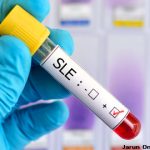 Childhood-onset systemic lupus erythematosus (SLE) differs from adult-onset SLE in many ways, including increased severity and abruptness of onset. Researchers from the School of Medical Science at the University of Campinas, Brazil, and the Judith & Stuart Colton Center for Autoimmunity at the New York University School of Medicine examined if these differences in presentation translated into a different genetic basis for the disease.
Childhood-onset systemic lupus erythematosus (SLE) differs from adult-onset SLE in many ways, including increased severity and abruptness of onset. Researchers from the School of Medical Science at the University of Campinas, Brazil, and the Judith & Stuart Colton Center for Autoimmunity at the New York University School of Medicine examined if these differences in presentation translated into a different genetic basis for the disease.
“The University of Campinas has a unique resource readily available to answer this question about genetics and inheritance in lupus,” says Timothy Niewold, MD, Judith & Stuart Colton Professor of Medicine and Pathology at New York University. “They have detailed family histories on large family structures [because] it is not uncommon to have six or more children [in Brazilian families]. If you are studying the inheritance of a rare condition, such as lupus, it helps to have many children per family.”
3 Generations Studied
The researchers looked at 392 consecutive SLE patients (112 childhood-onset and 280 adult-onset) seen at the Pediatric and Adult Outpatient Clinic of University of Campinas from January 2016 to December 2018. After confirming the patient fulfilled at least four of the ACR criteria for SLE, they were personally interviewed. Data on familial history were collected across three generations for each patient, and extended familial pedigrees were constructed.
Three hundred and ninety-two individuals were assessed. Researchers identified 2,574 first-degree relatives, 5,490 second-degree relatives and 6,805 third-degree relatives. If a patient’s first symptoms attributed to SLE occurred at or before the age of 18, they were defined as having childhood-onset SLE. Those diagnosed after 18 were placed in the adult-onset SLE group.
Medical histories, as well as the clinical and serological characteristics of the patients, were collected at diagnosis and follow-up. Researchers compared the presence of cumulative clinical manifestations, laboratory results and immunological features between single- and multiple-case SLE families. Disease activity was measured using the SLE Disease Activity Index (SLEDAI) at each visit, and adjusted scores were calculated over time. Cumulative disease-related damage in all patients was determined using the SLE International Collaborating Clinics/ACR Damage Index.
The relative recurrence rate of SLE was calculated for each degree of relation to the SLE patient.
Predicting Inheritance Patterns
“We used mathematical models to predict inheritance patterns; the subjects were not directly genotyped,” says Dr. Niewold. “We found childhood-onset disease was characterized by a larger number of risk factors, as predicted by the models.”



